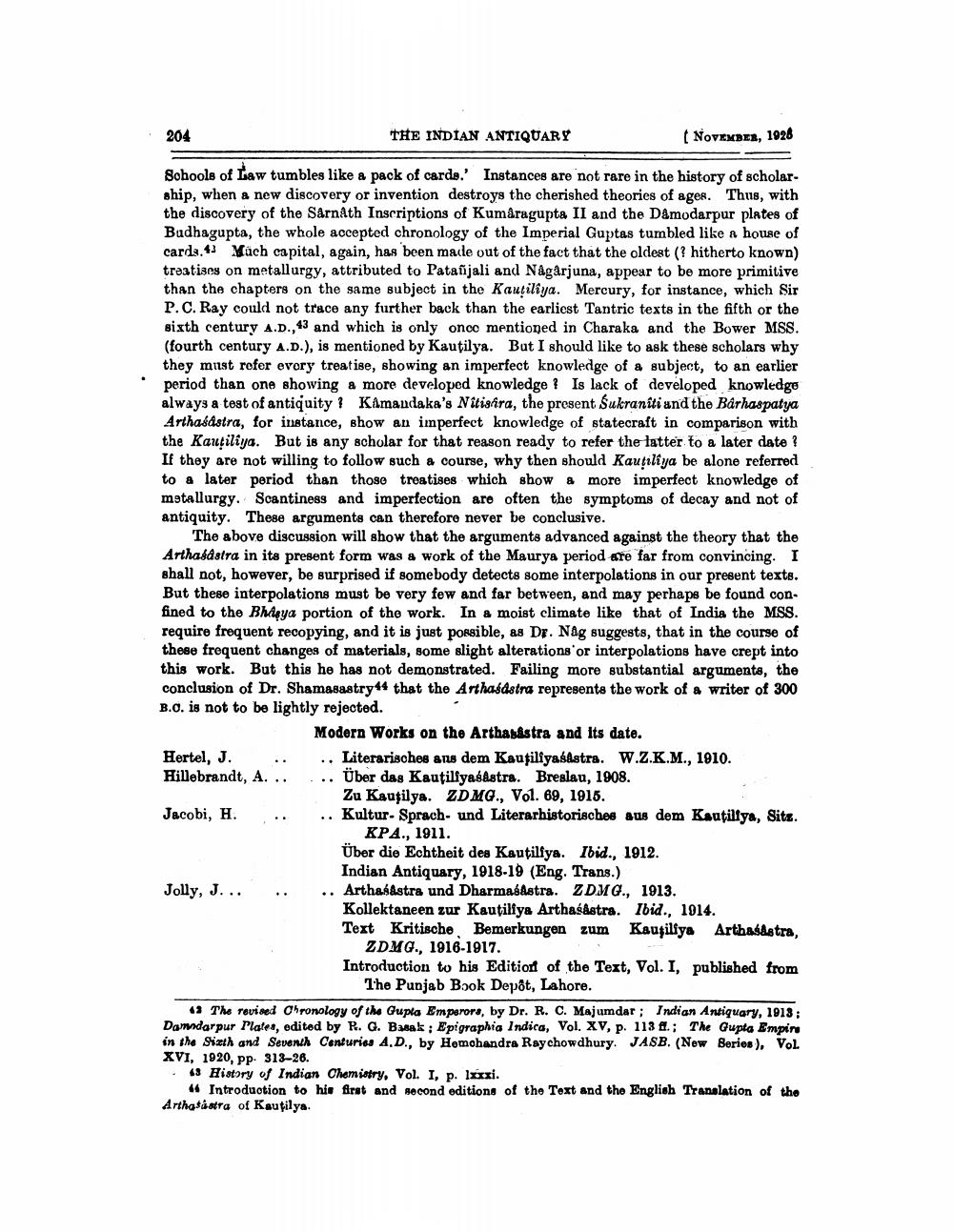________________
204
THE INDIAN ANTIQUARY
( NOVEMBER, 1926
Schools of Law tumbles like a pack of cards.' Instances are not rare in the history of scholarship, when a new discovery or invention destroys the cherished theories of ager. Thus, with the discovery of the Sarnath Inscriptions of Kumaragupta II and the Damodarpur plates of Badhagupta, the whole accepted chronology of the Imperial Guptas tumbled like a house of cards. Mach capital, again, has been made out of the fact that the oldest (? hitherto known) treatises on metallurgy, attributed to Patañjali and Nagarjuna, appear to be more primitive than the chapters on the same subject in the Kautiliya. Mercury, for instance, which Sir P.C. Ray could not trace any further back than the earliest Tantric texts in the fifth or the sixth century A.D., 43 and which is only onco mentioned in Charaka and the Bower MSS. (fourth century A.D.), is mentioned by Kautilya. But I should like to ask these scholars why they must refer every treatise, showing an imperfect knowledge of a subject, to an earlier period than one showing a more developed knowledge? Is lack of developed knowledge always a test of antiquity ? Kamandaka's Nitigira, the present Sukraniti and the Barhaspatya Arthasastra, for instance, show an imperfect knowledge of statecraft in comparison with the Kauçiliya. But is any scholar for that reason ready to refer the latter to a later date? If they are not willing to follow such a course, why then should Kautiliya be alone referred to a later period than those treatises which show & more imperfect knowledge of metallurgy. Scantiness and imperfection are often the symptoms of decay and not of antiquity. These arguments can therefore never be conclusive.
The above discussion will show that the arguments advanced against the theory that the Arthasastra in its present form was a work of the Maurya period are far from convincing. I shall not, however, be surprised if somebody detects some interpolations in our present texts. But these interpolations must be very few and far between, and may perhaps be found confined to the Bharya portion of the work. In & moist climate like that of India the MSS. require frequent recopying, and it is just possible, as Dr. Nag suggests, that in the course of these frequent changes of materials, some slight alterations or interpolations have crept into this work. But this he has not demonstrated. Failing more substantial arguments, the conclusion of Dr. Shamasastry 14 that the Arthasastna represents the work of a writer of 300 B.O. is not to be lightly rejected.
Modern Works on the Arthasastra and its date. Hertel, J. .. .. Literarisches aus dem Kaufiliyasastra. W.Z.K.M., 1910. Hillebrandt, A... ... Über das Kautilyasastra. Breslau, 1908.
Zu Kautilya. ZDMG., Vol. 69, 1915. Jacobi, H. .. .. Kultur- Sprach- und Literarhistorisches aus dem Kautilya, Site.
KPA., 1911. Über die Echtheit des Kautilfya. Ibid., 1912.
Indian Antiquary, 1918-19 (Eng. Trans.) Jolly, J... .. Arthasastra und Dharmasastra. ZDMG., 1913.
Kollektaneen zur Kautiliya Arthasastra. Ibid., 1014. Text Kritische Bemerkungen zum Kaufiliya Arthasastra,
ZDMG., 1916-1917. Introduction to his Edition of the Text, Vol. I, published from
The Punjab Book Depôt, Lahore. 13 The revised Chronology of the Gupta Emperora, by Dr. R. C. Majumdar; Indian Antiquary, 1913 : Damndarpur Platea, edited by P. G. Basak : Epigraphia Indica, Vol. XV, p. 113 fl.; The Gupta Empire in the Sixth and Seventh Centurios A.D., by Hemohandra Raychowdhury. JASB. (New Beries), VOL XVI, 1920, PP. 313–26. • 48 History of Indian Chemistry. Vol. I, p. lxxi.
4 Introduction to his first and second editions of the Text and the English Translation of the Arthatastra of Kautilya.




